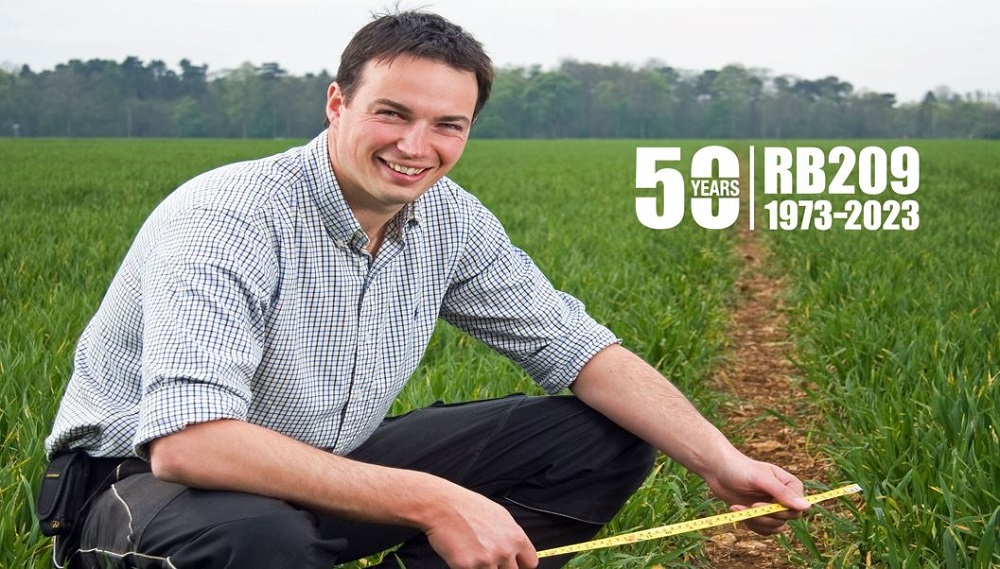RB209 hits 50, but does it have a future?
Friday, 29 September 2023
In 1973, Reference Bulletin 209 (RB209) collated nutrient management guidance for the first time. Listen to our Food & Farming podcast to discover how it has stood the test of time – and how it can stay relevant to crop production.
Listen to the podcast
In the podcast, three guest contributors provide their unique perspectives on RB209’s past, present and future.
- Ian Richards, an RB209 contributor (including to the first edition)
- James Price, a FACTS qualified farmer with a passion for nutrient management
- Amanda Bennett (pictured right), who oversees RB209’s production at AHDB
 AHDB
AHDB
Read about the podcast
RB209 and the first 50 years
In 1973, Ian Richards was a junior researcher at Fisons research station in Devon, where he specialised in grassland nutrition. It was a role that saw him contribute to the inaugural RB209 edition (and several subsequent editions).
In the 1970s, World War Two’s influence still gripped farm practice, with agricultural output a key driver in policy and guidance. It was a different world, and RB209 was a different beast. Its coverage was relatively narrow (manufactured fertilisers) compared with today’s comprehensive guidance.
Clutching a copy of the second edition (sadly, he doesn’t have a copy of the first edition), Ian pointed out that organic manure coverage was limited to seven lines of text and a small table in those early days.
Ian said:
“For a long time, organic materials were a side note in the guidance. The need to integrate organic materials is now obvious, but it wasn’t then. Organic materials didn’t get a dedicated section until the 1990s. Today, RB209 has become a true nutrient management guide.”
Ian is also a member of the Fertiliser Advisers Certification & Training Scheme (FACTS) Advisory Committee.
Since 1993, FACTS has set standards, led training and accredited the continuing professional development (CPD) of those providing nutrient management advice.
There are around 4,000 FACTS advisers and each one is armed with a copy of RB209.
About 200 to 250 people join the scheme each year, with each adviser taught and examined on RB209.
With FACTS advisers required to complete annual assessments to retain the qualification, it ensures farmers get the best nutrient management advice.
As the industry standard and the foundation of FACTS, Ian believes that RB209 will always be relevant.
RB209 history
From 1843 to the current day, read our article about the evolution of nutrient management information – from the early (MAFF and Defra) years to more recent AHDB-led developments.
A golden year for nutrient management (article)
RB209 on the farm
With a passion for crop nutrition, arable farmer James Price (pictured in the field) is never without his copy of RB209.
He farms at Perdiswell Farm in Oxfordshire, nestled near the historic market town of Woodstock.
James was a member of the AHDB Cereals & Oilseeds Board when AHDB took ownership of RB209 in 2015.
He felt it was a great opportunity to bring the guidance “in-house” and let farmers have more influence on it – from the research to the publication.
James takes a technical interest in nutrition and is among a growing group of farmers with a FACTS qualification.
According to James, nutrient management is the fundamental grounding to his farm business. The core team is FACTS qualified, which helps them build back organic matter levels and tailor nutrients to crop requirements.
RB209 proved particularly valuable recently when they decided to add oats to the rotation. As the team (including the farm’s agronomist) did not have much experience of growing oats, RB209 meant they did not need to start from scratch. The recent update to the guidance for oats also gave them confidence that their plan was optimised to deliver the best returns.
James will continue to use RB209 and refine the approach to oats as personal experience builds, flexing plans to meet the needs of the site.
His passion for nutrient management and its future helped him secure the chairmanship of the steering group that oversees the production of RB209.
RB209 and its production
RB209 revisions form part of a continual, robust and evidence-based production cycle. In the podcast, Amanda Bennett describes the iterative cycle that hones nutrient management guidance.
- Feedback gathered
RB209 is responsive to the needs of its primary users, which include farmers and FACTS qualified advisers (FQAs). Because RB209 underpins FACTS training, FQAs are particularly well placed to flag evidence gaps in nutrient management knowledge and help direct the development of the guidance.
- Research conducted
In 2015, AHDB founded the UK Partnership for Crop Nutrient Management, which comprises a steering group, supported by commodity-specific technical working groups (TWGs). A wide variety of stakeholders make up the partnership, which identifies and coordinates research activity.
Where trials are required, these are usually conducted over several years and sites to help manage the variation in results (which is frequently observed in nutrient management trials).
Following data analyses, researchers propose evidence-based changes to RB209.
- Proposed changes scrutinised
The partnership scrutinises the changes proposed and the underpinning evidence. A change is only granted when the evidence is robust and the solution is practical.
- Guidelines updated
Once the green light is given by the partnership, AHDB updates RB209 and arranges for its design, print and distribution.
Critically, AHDB also updates the RB209 API. Operating quietly in the background, the API is an online application that powers nutrient management calculations in numerous third-party nutrient management tools.
As a document that helps farmers apply fertiliser in an economically optimum way, Amanda believes it will always be relevant to farmers.
Amanda said:
“To keep the guidance relevant, we always need to consider changes to systems, practices and priorities.
“It is a good time to consider the longer-term needs of the industry and future investment in RB209. AHDB plans to conduct a formal review of RB209 soon.”
Further information
The current AHDB Cereals & Oilseeds sector plan (2022–2027) pledges to improve RB209, ensure it is based on the latest evidence and link it to soil management methods (where applicable).
Get your copy of RB209: ahdb.org.uk/rb209
Access soil management resources: ahdb.org.uk/greatsoils
Read the sector plans: ahdb.org.uk/sector-plans
 Mark Bassett
Mark Bassett


